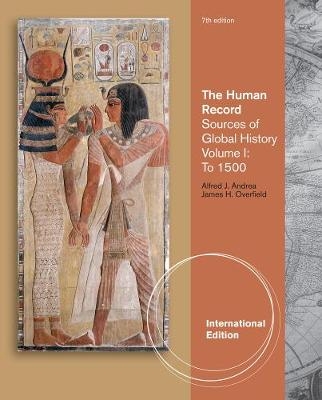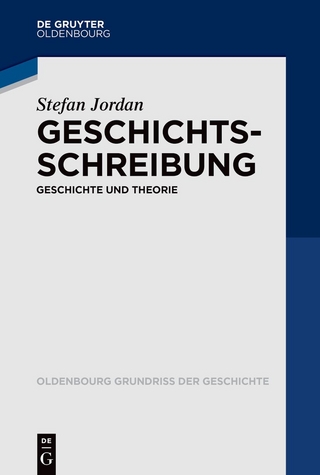
The Human Record
Wadsworth Publishing Co Inc (Verlag)
978-1-111-34135-0 (ISBN)
- Titel z.Zt. nicht lieferbar
- Versandkostenfrei
- Auch auf Rechnung
- Artikel merken
THE HUMAN RECORD, International Edition is the leading primary source reader for the World History course, providing balanced coverage of the global past. Each volume contains a blend of visual and textual sources which are often paired or grouped together for comparison. A prologue entitled “Primary Sources and How to Read Them” appears in each volume and provides background and guidance for analyzing sources such as those in the text. Approximately one-third of the sources in the Seventh Edition are new, and these documents continue to reflect the myriad experiences of the peoples of the world.
Alfred Andrea received his Ph.D. from Cornell University. He is Professor Emeritus of History at the University of Vermont, where he taught from 1967 through 2001. His initial training concentrated on medieval European history, with an emphasis on Byzantine-Western relations and the Crusades. He has since published four books on the Crusades, as well as numerous articles on a variety of historical issues. For the past thirty years, his teaching, research, and writing have focused increasingly on world history before 1600, with a particular interest in cross-cultural contacts across the Silk Road. In 2002 he was Distinguished Scholar-in-Residence at the University of Louisville, and he served as president of the World History Association (WHA) in 2010-2012. In 2014, the WHA recognized him as a Pioneer of World History. James H. Overfield, Professor Emeritus at the University of Vermont, received his BA from Dension University, his MA from the University of Chicago, and his PhD from Princeton University. During his career at Vermont he received the University’s outstanding teacher award, and served many years as Department of History Chair, in which capacity he was a strong advocate for the study and teaching of global history. His publications include Humanism and Scholasticism in Late Medieval Germany (Princeton University Press, 1984), as well as numerous articles on late medieval and early modern European thought. He served as editor for three volumes (1750-1914) of the ABC-CLIO World History Encyclopedia and is author of Sources of Global History since 1900 (Cengage: 2013).
Part I: THE ANCIENT WORLD.
1. The First Civilizations.
Mesopotamia: The Epic of Gilgamesh; The Judgments of Hammurabi. Egypt: The Satire on the Trades; Tale of the Eloquent Peasant. Bronze Age Societies: The Priest-King and the Hagia Triada Sarcophagus; Indus, Mesopotamian, and Cretan Seals. China: The Book of Documents; The Book of Songs.
Multiple Voices I: Art in the Service of the Monarchs of the Nile: Kneeling Figure of Queen Hatshepsut; A Relief of the Family of Akhenaten; Seti I and the Goddess Hathor; Temple Relief, Isis, Seti I, and Horus; Kushite King and Apedemak Horus.
2. Newcomers: From Nomads to Settlers.
The Indo-Europeans: The Rig Veda; Homer, The Odyssey; The Thera Kouros and the Peplos Kore. The Israelites and Their Neighbors: The Book of Genesis; The Book of Deuteronomy.
3. Transcendental Reality: Developing the Spiritual Traditions of India and Southwest Asia: 800-200 B.C.E.
The Emergence of Brahminical Hinduism: The Upanishads; The Bhagavad-Gita. The Teachings of the Buddha: The Buddha, Setting in Motion the Wheel of the Law; The Buddha, Questions That Tend Not to Edification. Persians, Israelites, and Their Gods: Zarathustra, Gathas; The Book of Isaiah.
4. The Secular Made Sacred: Developing the Humanistic Traditions of China and Hellas: 600-200 B.C.E.
China: Laozi, The Classic of the Way and Virtue; Confucius, The Analects; Sima Qian, Records of the Grand Historian. Hellenic Civilization: Herodotus, Histories, and the Golden Comb with Battle Scene; Euripedes, The Bacchae; Plato, Phaedo; Four Hellenic Works of Art.
Multiple Voices II: The Healing Arts in China, India, and Greece: The Yellow Emperor’s Classic of Internal Medicine, Great Treatise on the Harmony of the Atmosphere of the Four Seasons with the Human Spirit; Compendium of Caraka; Testimonials At Epidauros; Hippocrates, On the Sacred Disease; The Clinic Painter’s Aryballos.
5. Regional Empires and Afro-Eurasian Interchange: 300 B.C.E. – 500 C.E.
Han China: Huan Kuan, Discourses on Salt and Iron; Ban Zhao, Lessons for Women. Central Asia in the Age of Empires: Woman Standing on a Makara; A Bactrian Ewer in Northern China. India in the Age of Empires: Asoka, Rock and Pillar Edicts; Faxian, Travels. The Greco-Roman World: Four Hellenistic Works of Art; Caesar Augustus, The Accomplishments of the Deified Augustus; Caesar Augustus as Pontifex Maximus and a Cameo Portrait.
Multiple Voices III: Sea Routes and Silk Roads: Pliny the Elder, Natural History; Chronicle of the Western Regions; A Miran Mural and a Romano-Coptic Funerary Effigy of a Woman; Four Images of the Buddha; Faxian, Travels.
Part II: FAITH, DEVOTION, AND SALVATION: GREAT WORLD RELIGIONS TO 1500.
6. Universal Religions of Salvation in an Uncertain World: 1–600 C.E.
Bhakti: Two Images of Shiva. Mahayana Buddhism: Tales of Guanshiyin; Four Images of Guanyin. Two Different Religious Visions: Lucius Apuleius, Metamorphoses; The Babylonian Talmud. Christianity: The Gospel of Saint Matthew; Saint Paul, Epistle to the Romans. Conquering the World for Christ: The Good Shepherd and Christ Militant; Rufinus of Aquileia, Church History; Bishop Adam, The Christian Monument.
Multiple Voices IV: One Christianity or Many Christianities?: The Gospel of Thomas; Irenaeus, Against Heresies; Homilies of Clement; Eusebius of Caesarea, Ecclesiastical History; The Creed of Nicaea.
7. Islam: Universal Submission to God.
The Foundations of Islamic Life: The Quran; Abu Abdullah ibn Ismail al-Bukhari, The Authentic [Traditions]. Variety and Unity within Islam: Ibn Babawayh al-Saduq, Creed Concerning the Imams; Mahmud Kati, The Chronicle of the Seeker; Bihzad, Sufis Performing Sama.
Multiple Voices V: Islam and Unbelievers: The Pact of Ibn Muslama; The Pact of Umar; Al-Nawawi, Manual of Islamic Law; Benjamin of Tudela, Book of Travels; The Deeds of Sultan Firuz Shah.
Part III: CONTINUITY, CHANGE, AND INTERCHANGE: 500-1500.
8. Asia: Change in the Context of Tradition.
Japan: Chronicles of Japan; Sei Shonagon, The Pillow Book; Portrait of Minamoto Yoritomo and Removal of the Imperial Family to Rukuhara. China: Du Fu, Poems; A Sogdian Wine Merchant, The Bezelik Musicians, and Two Views of a Nomad Encampment. Southwest Asia: Al-Jahiz, The Merits of the Turks and of the Imperial Army As a Whole; Ibn Jubayr, Travels; A Thousand and One Arabian Nights; An Iranian Bowl. India: Abul Raihan al-Biruni, Description of India; Vikrama’s Adventures; The Lovers.
Multiple Voices VI: Buddhism in China: Acceptance, Rejection, and Accommodation: Shi Baochang, Lives of the Nuns; Han Yu, Memorial on Buddhism; Proclamation Ordering the Destruction of Buddhist Monasteries; Mandala of Vajabhairava.
9. Two Christian Civilizations: Byzantium and Western Europe.
An Empire and Its Emperors: The Mosaics of San Vitale; Michael Psellus, Chronographia. Emperors in the Latin West: Sacramentary of Charles the Bald; Liudprand of Cremona, A Report on the Embassy to Constantinople. Imperium Versus Sacerdotium: Dictatus Papae; Henry IV, Letter to Hildebrand; John of Paris, A Treatise on Royal and Papal Power; A Fresco from the Church of Quattro Coronati; Anna Comnena, Alexiad.
Multiple Voices VII: Byzantium and the West in the Age of the Crusades: The Dividing of Christendom?: Baldric of Dol, The Jerusalem History; Four Crusade Miniatures; Anna Comnena, Alexiad; Robert of Clari, The Capture of Constantinople; Nicetas Choniates, Annals; Innocent III, Letters To the Crusaders.
10. Africa and the Americas.
Africa: Abul-Hasan Ali al-Masudi, Meadows of Gold; Abu Ubaydallah al-Bakri, The Book of Routes and Realms; Two Icons of the Virgin Mary; Seated Male and Female Figures. The Americas: Adena Man and A Moche Seated Figure; Two Mayan Sculptures; Diego Durán, Book of the Gods and Rites; Pedro de Cieza de León, Chronicles.
11. Adventurers, Merchants, Diplomats, Pilgrims, and Missionaries: A Half Millennium of Travel and Encounter: 1000-1500.
The World Perceived: Zhau Rugua, A Description of Foreign Peoples; The Book of John Mandeville; Johann Bämler, Wondrous Fountains and Peoples; The Kangnido. Travel in the Age of the Pax Mongolica: William of Rubruck, Journey To the Land of the Tartars; Marco Polo, Description of the World; Odoric of Pordenone, Report; Francesco Pegolotti, The Practice of Commerce. Long-Distance Travel beyond the Mongol Peace: Ibn Battuta, A Gift to Those Who Contemplate the Wonders of Cities and The Marvels Encountered in Travel; Ruy González de Clavijo, Embassy To Tamerlane; Huan, The Overall Survey of the Ocean’s Shores; Christopher Columbus, A Letter Concerning Recently Discovered Islands.
| Erscheint lt. Verlag | 31.1.2011 |
|---|---|
| Verlagsort | Belmont, CA |
| Sprache | englisch |
| Maße | 187 x 232 mm |
| Gewicht | 696 g |
| Themenwelt | Geisteswissenschaften ► Geschichte ► Geschichtstheorie / Historik |
| ISBN-10 | 1-111-34135-4 / 1111341354 |
| ISBN-13 | 978-1-111-34135-0 / 9781111341350 |
| Zustand | Neuware |
| Haben Sie eine Frage zum Produkt? |
aus dem Bereich


